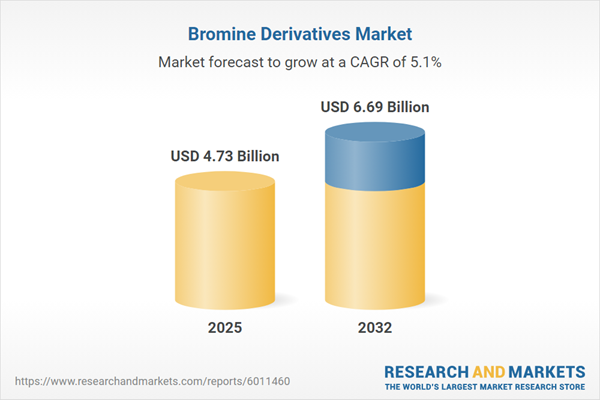Speak directly to the analyst to clarify any post sales queries you may have.
The bromine derivatives market is undergoing transformation as industries adapt to new regulatory environments, sustainability targets, and emerging technologies. Positioned at the crossroads of agriculture, energy, electronics, pharmaceuticals, and water treatment, stakeholders are leveraging innovative solutions and flexible business models to address shifting demands and risks.
Market Snapshot: Bromine Derivatives Market Growth Overview
The Bromine Derivatives Market grew from USD 4.50 billion in 2024 to USD 4.73 billion in 2025 and is projected to continue expanding at a CAGR of 5.08%, ultimately reaching USD 6.69 billion by 2032. This growth is being shaped by evolving end-user applications, regional production strategies, and ongoing regulatory changes.
Scope & Segmentation
This comprehensive report analyzes the global bromine derivatives ecosystem, including product innovation, application-specific developments, and global supply chain shifts. The market is segmented to deliver actionable insights into major decision areas:
- Application: Crop fumigation, drilling fluids, flame retardants, pharmaceutical intermediates, water treatment
- Derivative Type: Brominated epoxy, ethylene dibromide, methyl bromide, tetrabromobisphenol A
- End User Industry: Agriculture, construction, electrical electronics, oil and gas, pharmaceuticals
- Distribution Channel: Direct sales, distributors, e-commerce, web portals
- Chemical Form: Liquid, granules, powder
- Purity Grade: Industrial grade, analytical grade, research grade
- Production Method: Byproduct recovery (including chlor-alkali and oil refining tail gas), catalytic bromination, chemical synthesis (via chlorination route or direct bromination)
- Key Regions & Countries: United States, Canada, Mexico, Brazil, Argentina, Chile, Colombia, Peru, United Kingdom, Germany, France, Russia, Italy, Spain, Netherlands, Sweden, Poland, Switzerland, UAE, Saudi Arabia, Qatar, Turkey, Israel, South Africa, Nigeria, Egypt, Kenya, China, India, Japan, Australia, South Korea, Indonesia, Thailand, Malaysia, Singapore, Taiwan
- Market Participants: Albemarle Corporation, Israel Chemicals Ltd., LANXESS AG, Dow Chemical Company, Tosoh Corporation, Solvay SA, Occidental Chemical Corporation, Jordan Bromine Company, Mitsui Chemicals, Inc., Songwon Industrial Co., Ltd.
Bromine Derivatives Market: Key Takeaways
- Shifting regulatory requirements are accelerating the transition to lower-toxicity and high-performance brominated compounds, prompting continuous adaptation among manufacturers.
- Digitization across procurement and supply chains is improving transparency and delivery speed for buyers and distributors of bromine-based products.
- Regional production trends reveal an ongoing preference for byproduct recovery in areas with mature chlor-alkali and oil refining infrastructure; synthetic production is gaining ground where domestic feedstock is limited.
- Emergence of specialized purity grades is creating new commercial pathways, specifically targeting analytical and research grade requirements in R&D-focused sectors.
- Technological partnerships are enabling companies to meet the stricter performance and safety standards required by electronics, pharmaceuticals, and construction industries.
Tariff Impact: Evolving Supply Chain and Pricing Strategies
The introduction of new United States tariffs in 2025 has created substantial shifts within supply chains. Importers are reassessing procurement approaches and seeking partnerships to maintain margins, while domestic producers benefit from enhanced competitiveness. The resulting pricing volatility is driving innovation in contract structures and encouraging investment in alternative production technologies.
Methodology & Data Sources
This report combines primary research—through executive and technical interviews, along with distributor feedback—with secondary sources including corporate disclosures and technical publications. Data triangulation and independent laboratory standards were used to validate segmentation, production trends, and quality benchmarks, ensuring robust and reliable findings.
Why This Report Matters
- Enables executive teams to benchmark strategic options across technologies, production methods, and procurement practices within the bromine derivatives market.
- Equips leaders with data to anticipate regulatory, supply chain, and tariff-related market shifts that can affect profitability and operational continuity.
- Supports prioritization of investment, technology adoption, and distribution channel development to capture emerging segment opportunities.
Conclusion
Senior leaders pursuing growth and resilience in the bromine derivatives market should prioritize sustainable production, agile supply chains, and targeted research engagements. Integrated strategies will be key in navigating industry change, capitalizing on opportunities, and achieving compliance across global markets.
Additional Product Information:
- Purchase of this report includes 1 year online access with quarterly updates.
- This report can be updated on request. Please contact our Customer Experience team using the Ask a Question widget on our website.
Table of Contents
3. Executive Summary
4. Market Overview
7. Cumulative Impact of Artificial Intelligence 2025
Companies Mentioned
The companies profiled in this Bromine Derivatives market report include:- Albemarle Corporation
- Israel Chemicals Ltd.
- LANXESS AG
- Dow Chemical Company
- Tosoh Corporation
- Solvay SA
- Occidental Chemical Corporation
- Jordan Bromine Company
- Mitsui Chemicals, Inc.
- Songwon Industrial Co., Ltd.
Table Information
| Report Attribute | Details |
|---|---|
| No. of Pages | 192 |
| Published | November 2025 |
| Forecast Period | 2025 - 2032 |
| Estimated Market Value ( USD | $ 4.73 Billion |
| Forecasted Market Value ( USD | $ 6.69 Billion |
| Compound Annual Growth Rate | 5.0% |
| Regions Covered | Global |
| No. of Companies Mentioned | 11 |









